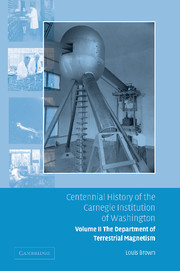Book contents
- Frontmatter
- Contents
- Foreword by Richard A. Meserve
- Preface
- 1 Establishment
- 2 Cruises and war
- 3 Expeditions
- 4 Measurements: magnetic and electric
- 5 The Fleming transition
- 6 The last cruise
- 7 The magnetic observatories and final land observations
- 8 The ionosphere
- 9 Collaboration and evaluation
- 10 The Tesla coil
- 11 The Van de Graaff accelerator
- 12 The nuclear force
- 13 Fission
- 14 Cosmic rays
- 15 The proximity fuze and the war effort
- 16 The Tuve transition
- 17 Postwar nuclear physics
- 18 The cyclotron
- 19 Biophysics
- 20 Explosion seismology
- 21 Isotope geology
- 22 Radio astronomy
- 23 Image tubes
- 24 Computers
- 25 Earthquake seismology
- 26 Strainmeters
- 27 The Bolton and Wetherill years
- 28 Astronomy
- 29 The solar system
- 30 Geochemistry
- 31 Island-arc volcanoes
- 32 Seismology revisited
- 33 Geochemistry and cosmochemistry
- 34 The Solomon transition
- 35 The support staff
- 36 Epilogue
- Notes
- Index
11 - The Van de Graaff accelerator
Published online by Cambridge University Press: 06 January 2010
- Frontmatter
- Contents
- Foreword by Richard A. Meserve
- Preface
- 1 Establishment
- 2 Cruises and war
- 3 Expeditions
- 4 Measurements: magnetic and electric
- 5 The Fleming transition
- 6 The last cruise
- 7 The magnetic observatories and final land observations
- 8 The ionosphere
- 9 Collaboration and evaluation
- 10 The Tesla coil
- 11 The Van de Graaff accelerator
- 12 The nuclear force
- 13 Fission
- 14 Cosmic rays
- 15 The proximity fuze and the war effort
- 16 The Tuve transition
- 17 Postwar nuclear physics
- 18 The cyclotron
- 19 Biophysics
- 20 Explosion seismology
- 21 Isotope geology
- 22 Radio astronomy
- 23 Image tubes
- 24 Computers
- 25 Earthquake seismology
- 26 Strainmeters
- 27 The Bolton and Wetherill years
- 28 Astronomy
- 29 The solar system
- 30 Geochemistry
- 31 Island-arc volcanoes
- 32 Seismology revisited
- 33 Geochemistry and cosmochemistry
- 34 The Solomon transition
- 35 The support staff
- 36 Epilogue
- Notes
- Index
Summary
Electrostatic generators had been invented in the latter part of the eighteenth century, but all were limited in their maximum voltages by the insulation available to a tabletop machine. In 1931 Robert Van de Graaff published his invention of an electrostatic generator – now well known to the public and at school science fairs – that could have insulation limited only by the size of the support column. He knew, of course, of the DTM high-voltage work and offered to cooperate in evaluating his machine as an accelerator. Tuve brought two small machines along with the inventor from Princeton for a crucial experiment: could one of the vacuum accelerator tubes made for the Tesla coil hold the voltages applied? This was important because one of the arguments in favor of alternating voltages had been that direct voltages were difficult to handle, something that was certainly true for electric power.
The two machines were set up in the Experiment Building where, despite the restricted space and their relatively small size, they delivered 500 kV to 600 kV, but best of all one of the Tesla-coil tubes was found to hold such potentials with no effort and without oil! Above 550 kV sparks occurred across the whole tube but without damaging it, owing to the relatively small amount of energy released. This tube had evolved through a survival of the fittest in the Tesla jungle, and the electrostatic generator could not destroy it.
- Type
- Chapter
- Information
- Publisher: Cambridge University PressPrint publication year: 2005



